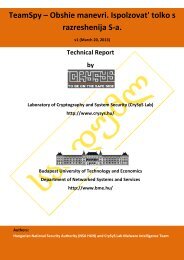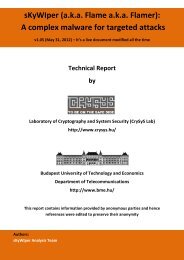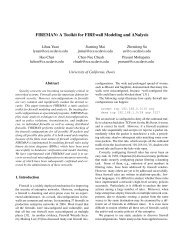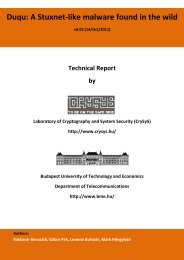Create successful ePaper yourself
Turn your PDF publications into a flip-book with our unique Google optimized e-Paper software.
Chapter 2<br />
Private Authentication in Resource<br />
Constrained Environments<br />
2.1 Introduction to private authentication<br />
Entity authentication is the process whereby a party (the prover) corroborates its identity to<br />
another party (the verifier). Entity authentication is often based on authentication protocols in<br />
which the parties pass messages to each other. These protocols are engineered in such a way that<br />
they resist various types of impersonation and replay attacks [Boyd and Mathuria, 2003]. However,<br />
less attention is paid to the requirement of preserving the privacy of the parties (typically that of<br />
the prover) with respect to an eavesdropping third party. Indeed, in many of the well-known and<br />
widely used authentication protocols (e.g., [ISO, 2008; Kohl and Neuman, 1993]) the identity of<br />
the prover is sent in cleartext, and hence, it is revealed to an eavesdropper.<br />
One approach to solve this problem is based on public key cryptography, and it consists of<br />
encrypting the identity information of the prover with the public key of the verifier so that no<br />
one but the verifier can learn the prover’s identity [Abadi and Fournet, 2004]. Another approach,<br />
also based on public key techniques, is that the parties first run an anonymous Diffie-Hellman key<br />
exchange and establish a confidential channel, through which the prover can send its identity and<br />
authentication information to the verifier in a second step. An example for this second approach is<br />
the main mode of the Internet Key Exchange (IKE and IKEv2) protocol [Harkins and Carrel, 1998;<br />
Black and McGrew, 2008]. While it is possible to hide the identity of the prover by using the above<br />
mentioned approaches, they provide appropriate solution to the problem only if the parties can<br />
afford public key cryptography. In many applications, such as low cost RFID tags and contactless<br />
smart card based automated fare collection systems in mass transportation, this is not the case,<br />
while at the same time, the provision of privacy (especially location privacy) in those systems is<br />
strongly desirable.<br />
The problem of using symmetric key encryption to hide the identity of the prover is that<br />
the verifier does not know which symmetric key it should use to decrypt the encrypted identity,<br />
because the appropriate key cannot be retrieved without the identity. The verifier may try all<br />
possible keys in its key database until one of them properly decrypts the encrypted identity 1 , but<br />
this would increase the authentication delay if the number of potential provers is large. Long<br />
authentication delays are usually not desirable, moreover, in some cases, they may not even be<br />
acceptable. As an example, let us consider again contactless smart card based electronic tickets<br />
in public transportation: the number of smart cards in the system (i.e., the number of potential<br />
provers) may be very large in big cities, while the time needed to authenticate a card should be<br />
short in order to ensure a high throughput of passengers and avoid long queues at entry points.<br />
1 This of course requires redundancy in the encrypted message so that the verifier can determine if the decryption<br />
was successful.<br />
9












